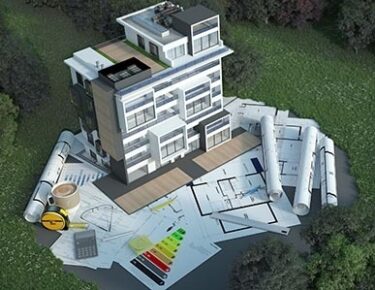 Fire Resistance
Fire Resistance
A glossary of essential fire-related terms
Learn the language of fire protection to make informed decisions that safeguard structures and their occupants

Fire safety is the cornerstone of modern building design, playing a critical role in protecting both property and lives. For architects, contractors and construction professionals, achieving compliance with fire-related building codes is not just a regulatory requirement — it’s a fundamental responsibility. But navigating the technical language of fire protection can be daunting without a clear understanding of key terms and concepts.
This fire safety glossary provides a comprehensive overview of fire-related terms, designed to serve as a valuable resource for professionals aiming to meet stringent building code requirements. From understanding fire-resistance ratings to the nuances of passive fire protection systems, mastering this vocabulary is essential for making informed decisions that uphold the integrity of a building and the safety of its occupants.
Fire-rated assemblies: foundations of life safety
These structures are tested and certified to slow fire spread, providing essential time for occupants to evacuate and for firefighters to respond.
- Fire-resistance rating (fire rating): The amount of time (in hours) an assembly can withstand fire exposure when tested in accordance with ASTM E119 or UL 263.
- Fire-rated assembly: A construction system (walls, columns, beams, floor-ceiling and roof-ceiling assemblies) built to resist fire spread for a specified period of time.
- Fire partition: A vertical fire-rated assembly that is continuous from the foundation or floor-ceiling assembly to the underside of a floor-ceiling or roof-ceiling assembly that has a fire rating equal to or greater than the partition often used for separating corridors or dwelling units.
- Fire barrier: A vertical fire-rated assembly that is continuous from the foundation or floor-ceiling assembly to the underside of the floor or roof deck above or a horizontal assembly such as a horizontal membrane or floor-ceiling or roof-ceiling assembly.
- Fire wall: A vertical fire-rated assembly that is continuous from the foundation to (or through) the roof designed to restrict the spread of fire and allow the collapse of the structure on either side without collapse of the wall and the structure on the opposite side.
- Area Separation Wall (ASW): A fire wall constructed with shaftliner panels and H-studs primarily used for separating fire areas in residential construction
For architects, contractors and construction professionals, achieving compliance with fire-related building codes is not just a regulatory requirement — it’s a fundamental responsibility.
Sam Halverson
Sam Halverson
Construction Services Manager, National Gypsum 1-800-NATIONAL® Construction Services teamCodes and standards: ensuring compliance and safety
These code-referenced consensus standards give architects and builders confidence their projects comply with critical codes and guidelines.
- ASTM International: A standards organization that develops consensus technical standards that ensure the quality and reliability of materials, products, systems and services across a wide range of industries
- ASTM E119 (UL 263): The standard test method for determining the fire-resistance rating of construction materials and assemblies.
- ASTM E84: The standard test method used to measure the flame spread and smoke development of finish materials when exposed to fire.
- ASTM E136: The standard test method for assessing the combustibility of materials.
- UL Solutions: A company that offers testing, inspection, and certification services to demonstrate safety, enhance sustainability, strengthen security, deliver quality, manage risk and achieve regulatory compliance
- UL design: A construction assembly certified by UL for meeting specific fire-resistance design criteria.
- NFPA 101: A consensus standard published by the National Fire Protection Association focusing on building safety and fire protection often referenced in state and model building codes.
- International Fire Code: A model building code developed by the International Code Council (ICC) focused on building safety and fire protection.
RESOURCES: Learn more about ASTM standards and UL type designations.

Core technologies: fire-rated gypsum innovations
Specialized gypsum cores and boards, provided by National Gypsum Company through its affiliate Gold Bond Building Products, LLC, are designed to withstand extreme conditions, offering both safety and performance in fire-rated assemblies.
- Gypsum core types: The various core formulations — including standard, Type X and Type C — designed for specific fire performance requirements.
- UL Type Designation: The reference code for each gypsum board product. FSW, FSW-C, FSLX for example – learn more in our “Decoding UL type designations” blog post.
- Type X gypsum board: A gypsum board with additives such as fiberglass to enhance fire resistance, required in fire-rated assemblies.
- Type C gypsum board: An enhanced Type X gypsum board with additives for superior fire resistance, maintaining structural integrity longer than standard Type X boards.
- Fire-Shield® Gypsum Board: Manufactured by Gold Bond, this fire-resistant wallboard is designed for high-performance fire-rated assemblies.
- eXP® family of products: Moisture- and mold-resistant interior gypsum panels and exterior sheathing featuring glass mat facers manufactured by Gold Bond with enhanced fire-resistant properties.

Building components: enhancing fire safety
From walls to ceilings, products provided by National Gypsum integrate seamlessly into assemblies that meet the most stringent fire safety requirements.
- Asymmetric wall assemblies: These fire-rated partitions (also called unbalanced or one-sided) with unequal layers of gypsum board on each side are designed to be constructed from one side while providing fire protection from both sides of the partition.
- Chase wall: A double-stud wall assembly used for plumbing walls or where a high sound transmission class (STC) is desired.
- Shaftwall: A fire-rated wall system constructed from one side utilizing shaftliner panels and CT, CH or I-studs to enclose elevators, stairwells, or mechanical systems.
- Smoke partition: A structure designed to restrict the passage of smoke within a building.
- Smoke barrier: A structure designed to restrict the passage of smoke within a building and has a minimum 1-hour fire rating.
- Thermal barrier: A layer of material used to slow the transfer of heat, often used to protect combustible materials in a fire.
- Firestop: A system, device or material used to seal openings in fire-rated assemblies to prevent the spread of fire and smoke.
- Fire blocking: Materials used to prevent the spread of fire within concealed spaces in walls and floor assemblies.
Performance metrics: understanding fire dynamics
Fire safety isn’t just about stopping flames — it’s also about understanding how materials perform under fire conditions.
- Calcination: The chemical process that occurs when the water within a gypsum board is heated and released as steam.
- Ignition temperature: The minimum temperature at which a material will ignite without an external flame.
- Flame spread index: A measure of how quickly flames spread across the surface of a material, tested according to ASTM E84.
- Smoke development: A measure of how much smoke is generated from finish materials exposed to fire, tested according to ASTM E84.

Building with fire safety in mind
Understanding gypsum core types and their fire-resistant properties is essential for designing safe, code-compliant structures. If you’re looking to deepen your knowledge, National Gypsum offers several resources tailored to construction professionals:
- The PURPLE Book®: The only resource in the industry that illustrates in detail how fire-rated gypsum assemblies intersect with other building components, such as elevator shafts or steel beams.
- The Wood Book™: A comprehensive guide focusing on fire-rated wood-frame assemblies.
- NGC Construction Guide™: Now in its 15th edition, an essential reference guide featuring product information, installation instructions and technical guidance
Visit the Design & Resource Center for additional literature, specifications and tools to ensure your projects meet the highest standards for safety and performance.
Be the first to hear of new NGConnects blog posts by subscribing here for early access.
Related Blog Posts

Fire & Sound Assembly Selector simplifies choosing UL designs
Interactive resource provides tested assemblies based on your pro...
Read MoreRelated Podcasts

Episode 4: Understanding the ratings behind acoustical wall, ceiling and roof assemblies
Familiarize yourself with STC, IIC, CAC and OITC rating classes a...
Listen Now






